Disclosure: Meeple Mountain received a free copy of this product in exchange for an honest, unbiased review. This review is not intended to be an endorsement.
Most games I have reviewed for Meeple Mountain have taken some of the best elements of recent board games and put their personalized spin to give the product a slightly different flavor. Maybe it is mechanics; worker placement…and deck building! Or maybe this time the theme isn’t 18th-century Europe…we’re in space!
However, the upcoming game Oros, designed by Brandt Brinkerhoff and published by Ӕsc Games, takes some of the things you know well—action selection, tile placement, a player board that unlocks progressively-better powers over the course of the game—and then places gamers in the roles of gods with the power to literally move mountains.
On the surface, that pitch didn’t sound terribly unique, but the artwork of Oros really shines so I raised my hand to review a prototype of the game. Then I read the rules, and the main hook of the game revealed itself: the board state changes almost every turn, and the players have to constantly bend the shape of the board to accomplish their goals.
Oros is a challenging game because it requires even experienced gamers to think differently, more spatially, than they do in other games. For a very specific type of player, Oros will really shine.

Passion has a new name!
At Meeple Mountain we typically spend time in the middle of our reviews giving you at least some of a game’s rules. However, I’m going to start by linking directly to this rules video if you want to really learn how to play Oros. The teach takes 20 minutes, but this is the most passionate how-to-play video I have ever seen. I truly believe this video is worth watching even if you have no interest in the game because it’s so good and I just love how much the narrator (the game’s designer) loves talking about the gameplay.
Here’s the short version of how to play Oros: you take on the role of a Demigod with the power to change the landscape of the world. Over a series of rounds, you and your rivals will take three actions per turn to change the board in a variety of ways. Use your pool of followers to collide land tiles to form mountains and volcanoes, build sacred sites on mountain tiles, and shift sections of the board to make it easier for your followers to cross land tiles. You’ll also need to give your followers chances to gain wisdom (by studying at sites on the board and on your player mat) to increase flexibility for what each of your action spaces allow you to do.
The game board of Oros represents an area of land that you’ll have to manipulate throughout the game; the board is two-sided, with a smaller version of ocean and land for 1-4 players which is recommended for your initial plays. On that board is a grid of tile spaces for various sizes of land tiles ranked from size 1—a tiny island—to 4, a full landmass that is not yet a mountain.
Most importantly, the edges of the map are adjacent to each other in every direction off of the map…meaning that a tile in the southwest corner of your map is actually next to one that is in the northeast corner of the map, and the one in the northwest corner of the map. And this also means that the map of Oros allows for shifting tiles in certain directions that make them wrap in a loop around the board without changing their order.
Are you still with me?

The basics are mostly basic
Looking at your player mat, you’ll see that a few of your actions are vanilla ice cream, in terms of simplicity. Depending on the game situation, you’ll need to “journey” with your followers by moving them across connected land tiles. You may also need to build sacred sites on the map, which allow you to build a single site on a mountain tile in your player color depending on what else is there when you build.
Building, and then moving your Demigod pawn up a pyramid scoring track called the ziggurat, is the main way Oros tracks towards its endgame. When one player’s Demigod reaches the top of the ziggurat, players finish out the current round and use their position on the ziggurat to score that number of points plus others on their respective player mats.
One action allows for a player to intentionally erupt volcanoes and/or create them on certain tiles on the board, allowing you to spill volcanic land into adjacent tiles to form larger landmasses. This action, in combination with your “Move land tiles one space” action, allows you to mash 4-size landmass tiles together to form mountains. To line things up better, you can also “Shift ALL land tiles in a row” to get the right tiles in the right places to get those sweet, sweet 4-size landmass tiles in position.
All the while, you can and should be using the “Send ONE [follower] to study or return up to TWO [followers]” action, because the only way to unlock better versions of each action on your player board is to gain wisdom, which opens up cool options that you’ll need to better manage the shifting board state.
The actions are initially easy to explain. But this is where I find Oros will either really shine for you and your gaming group, or it will not: teaching new players how tiles shift and move to create opportunities.
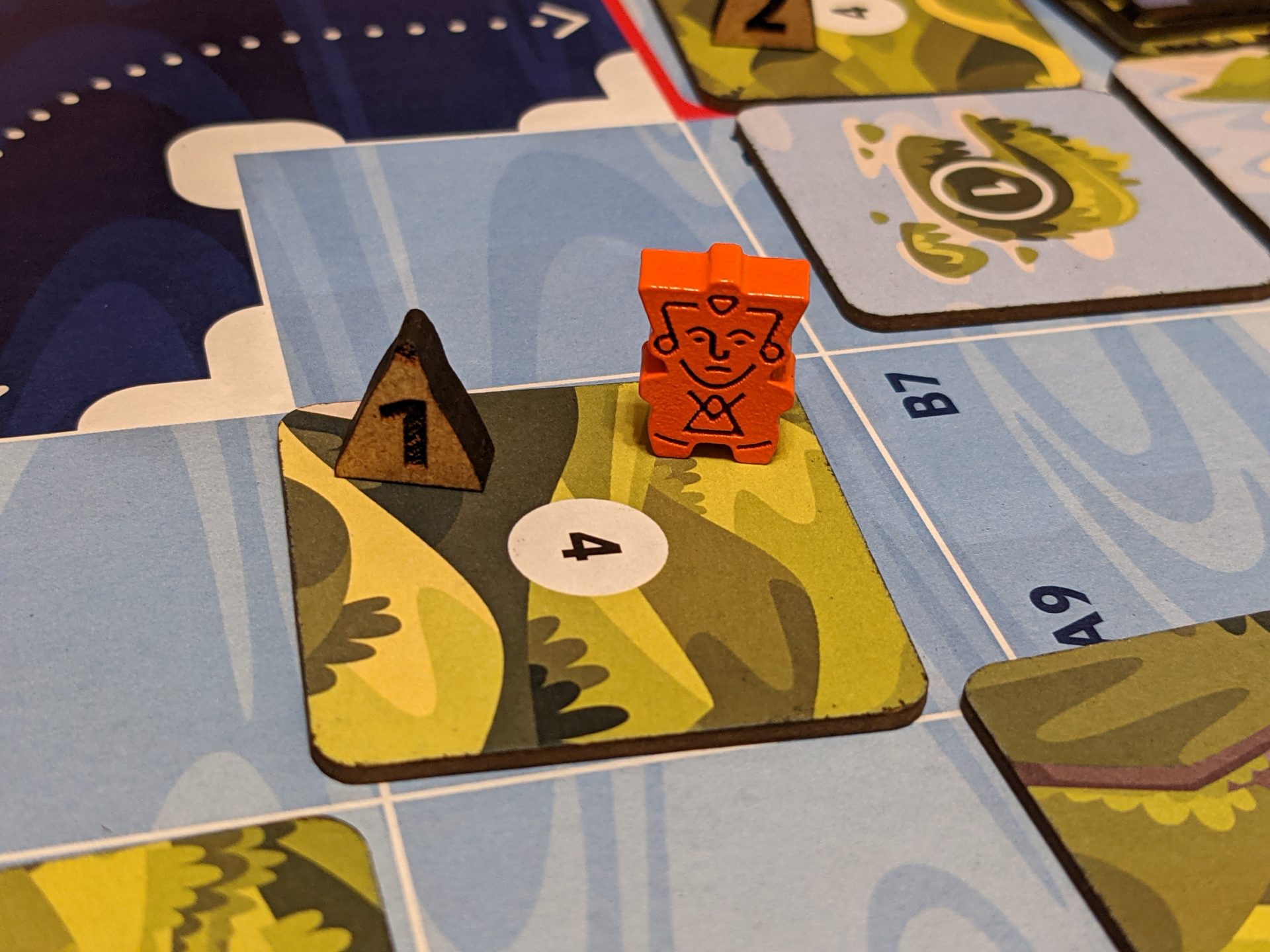
So, you’re saying that this tile…is adjacent to that tile?
The heart of Oros is watching a player use their three actions and the followers on their player mat to make and move mountains, build a sacred site on a tile, and increase their wisdom to make another action that they could take on their same turn even better. I think Oros has chances for lots of really cool moments, moments which other players will likely talk about well after the game has ended.
As we joked after my first three-player game, I’m not sure I’m creative enough to always see these opportunities. Like all games, Oros rewards the player invested in multiple plays. Where this changes for Oros players is seeing the board as it was designed—not as a flat board but as a full, round world, which is vital for seeing how to use, say, diagonal move actions to collide tiles that you might not realize are adjacent until your fourth “ooooohhh” moment in a game for a new player.
Teaching Oros to new players will be challenging, if my experiences so far are any indication. Thankfully, the rulebook has lots of examples of how certain actions will play out, and even after a few plays I find myself going back to look at those again and again. Also, Oros is a bit of a slow starter. There are no mountains on the board, and it takes a couple of rounds to smash land tiles together, and since players will start far away from each other, it takes a bit to get close enough to walk onto a mountain tile (and take advantage of someone else building on a site where your followers might be studying).
In some ways, I like the slow start. In other ways I wish the base game started with a mountain already on it, to maybe encourage players to try and reach that initial site to build on, to give players something to aim at.
Once Oros gets going—there are a couple of mountain tiles on the board, players are hopscotching each other on the ziggurat track while working with upgraded actions—the game really clicks. The other thing that really makes it click: the automa programming, which is required for a 1- or 2-player game (because three Demigods is the minimum character count). I highly recommend using the automa to always ensure you have four factions on the board, because even for a group that is not super creative. Having the automa means that the game board will automatically be shifting every single round.
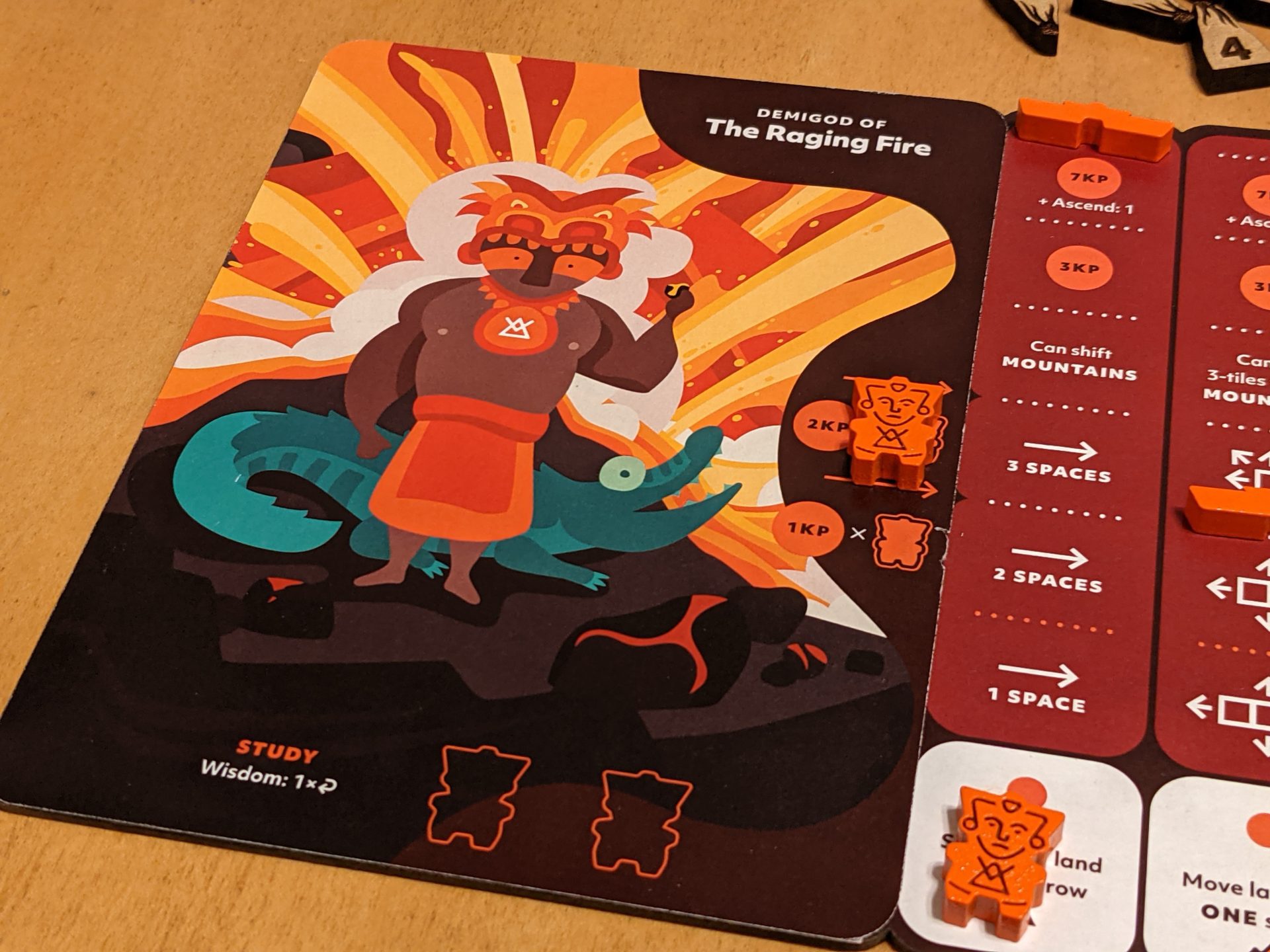
Wait…I basically HAVE to play with an AI??
Bear with me here. I know that in some games, solo AI driven by a “personality” doesn’t work. I’m really excited to say that in Oros, it not only works but I actually prefer the game as a solo experience with two automa in the game over playing it with three human beings.
There are a couple of reasons for this. At the end of the day, Oros is about solving a puzzle, a puzzle similar to some of the great brain-teasers in GAMES Magazine a million years ago. I enjoyed the puzzle more with the quick automa card deck actions than waiting minutes for human players to struggle through much of the analysis paralysis tied to making the right decision on how to take three actions.
The second reason? We have to be honest: many gamers like to play a game just a couple of times before moving on. I have three different game groups that I play with each month and all of us bring different games to hit the table each time we get together. I don’t have a small group of three other friends where one person puts most of the games out on the table. If I did, and I knew I could get that group to play Oros 8-10 times, I think we could do a 4-player game regularly in about 90 minutes and have a great time.
But to teach and re-teach Oros regularly? That would be a stretch for me, and I really think an experienced Oros player would regularly crush new players, even if they are experienced gamers. I love games that give all players a roughly equal chance to win, even if they are new to that product, and the tile movement/shifting system of Oros is a bit tougher to grasp.
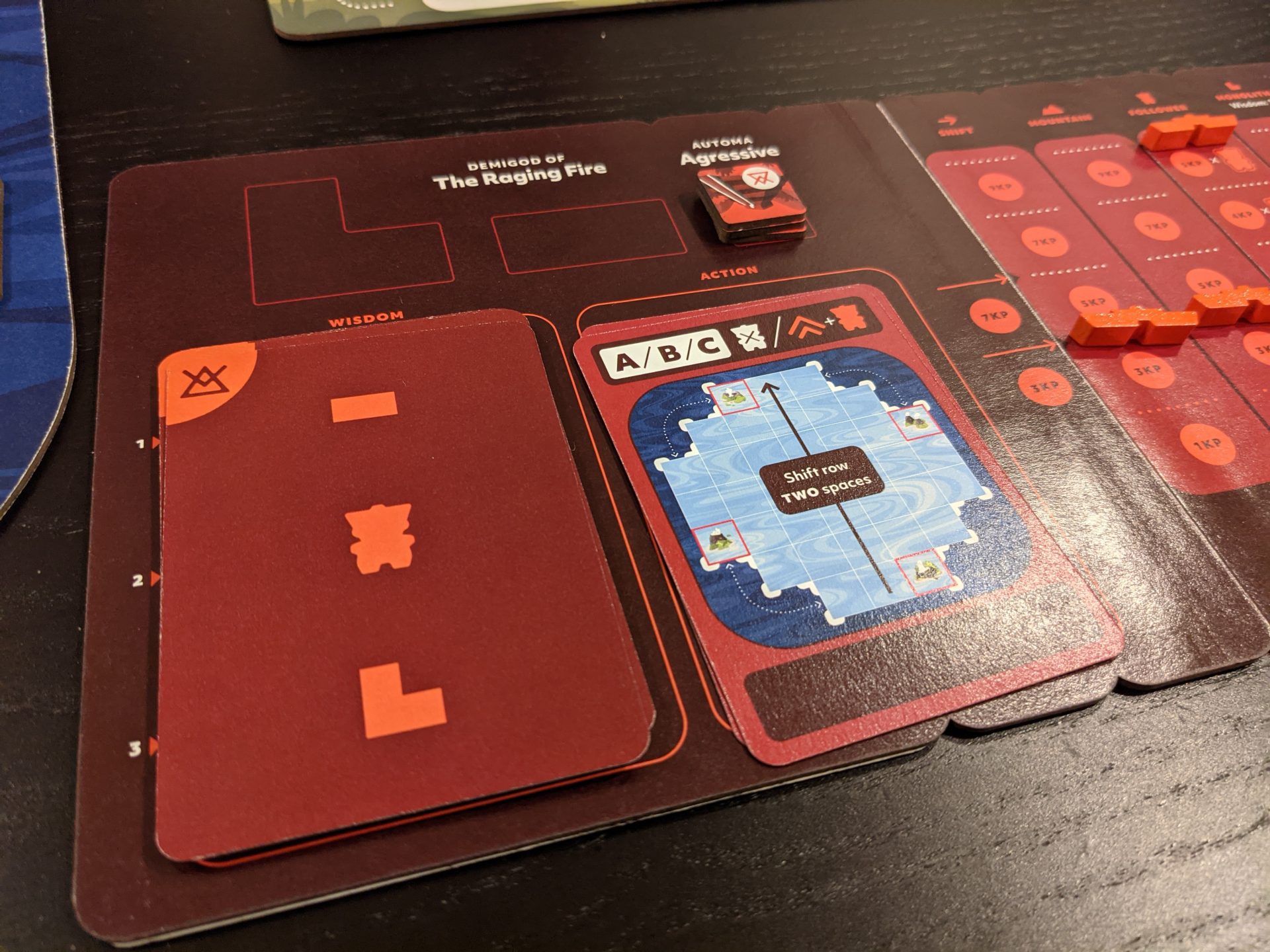
So, is Oros for you?
Oros is a good game. Even though I played a prototype, the artwork is great, the rulebook is incredible and the production quality of the demo was strong. The gameplay has lots of chances for big moments, and with the exception of Hansa Teutonica, no game I have played this year rewards creativity quite as well as Oros does.
Creativity is also the rub with Oros. I think Oros will shine brightest with a consistent group of four spatially-creative gamers who will give the game the time it deserves to regularly hit the table and explore a variety of approaches to really knock it out of the park.
Alternatively, a solo gamer will really love how the three automa flavors (Friendly, Competitive and Aggressive) change the experience to help teach the game. And these automa can and should be used to fill any open player spot so that you always have a 4-player game—or 4-”player” game, a mix of human and automa players—each time Oros gets a run.
A fun experience for the right audience. Be sure to check out the Kickstarter campaign for Oros this summer!


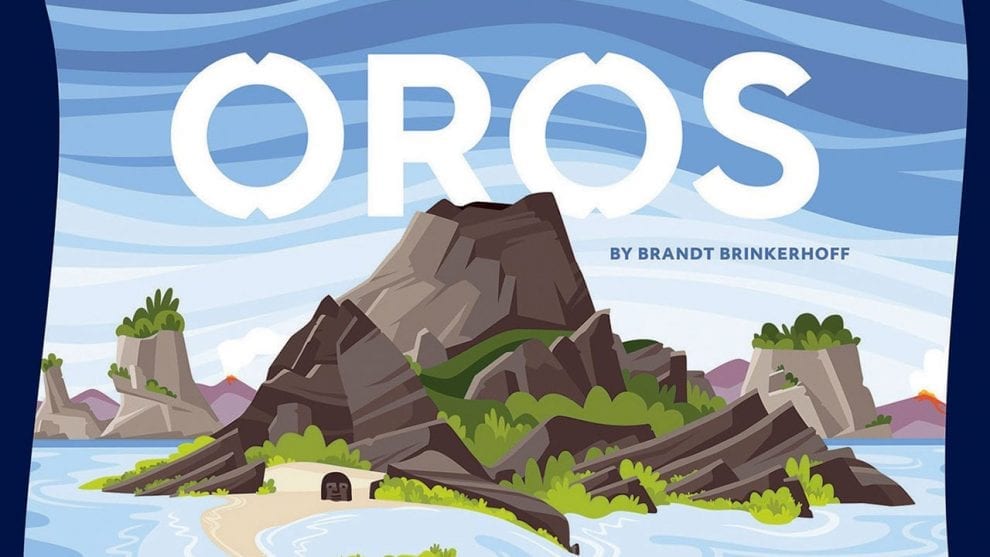



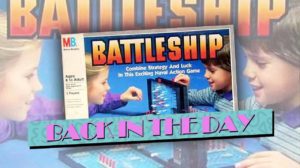





Add Comment